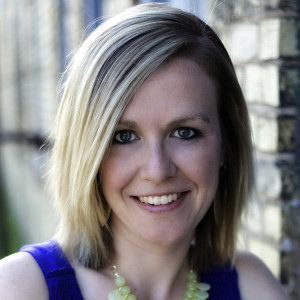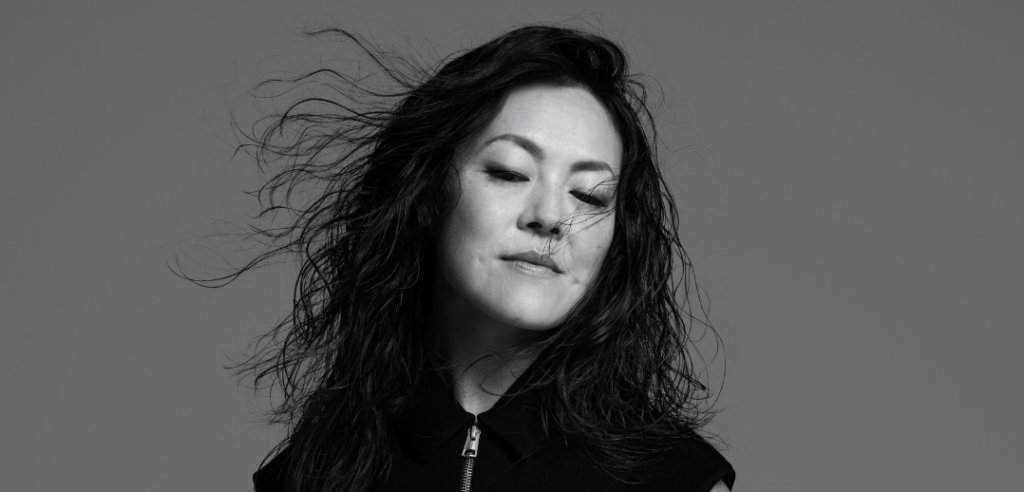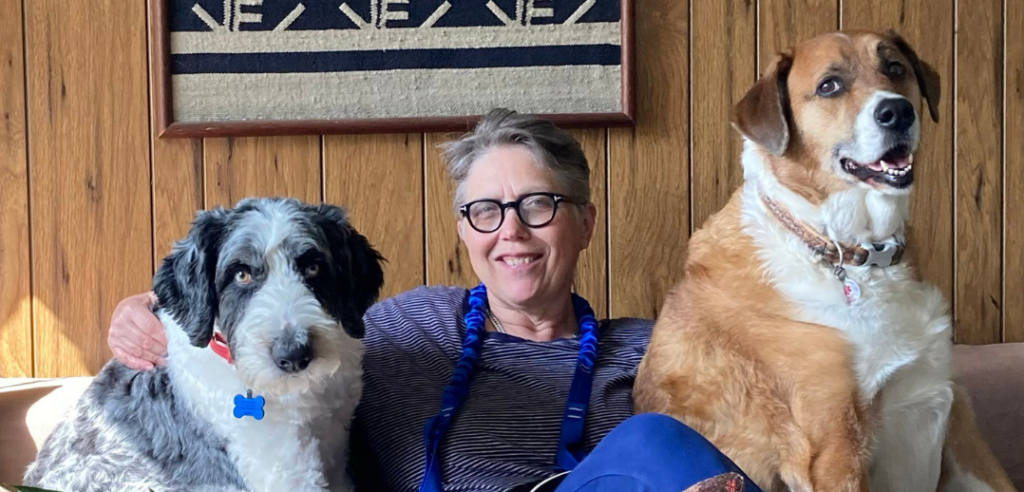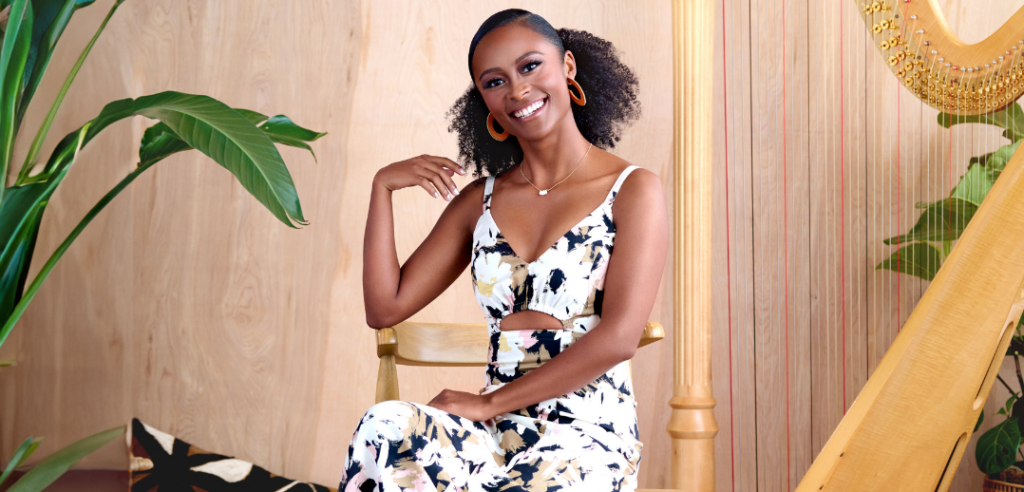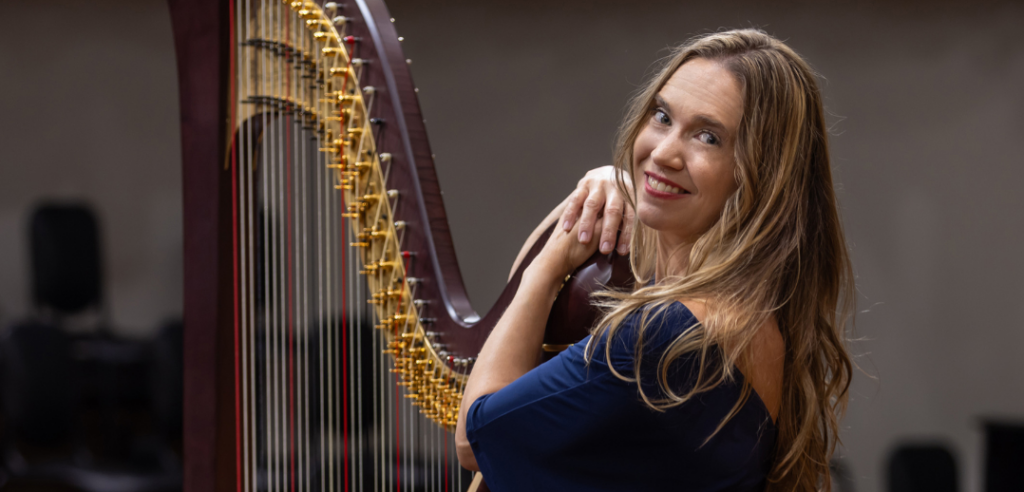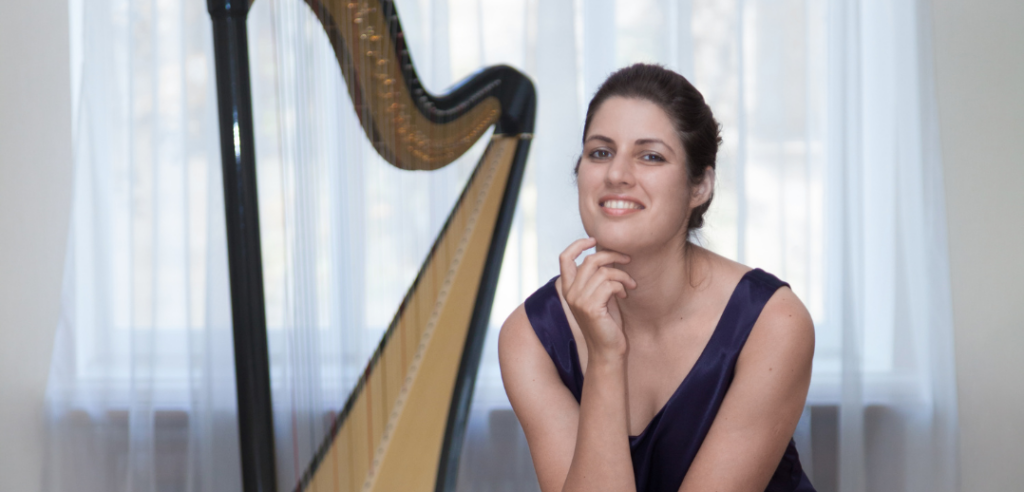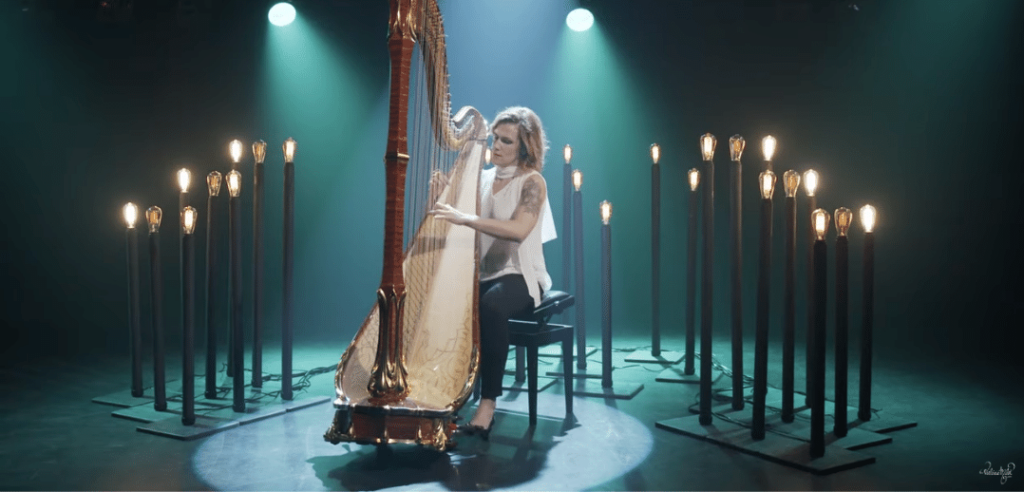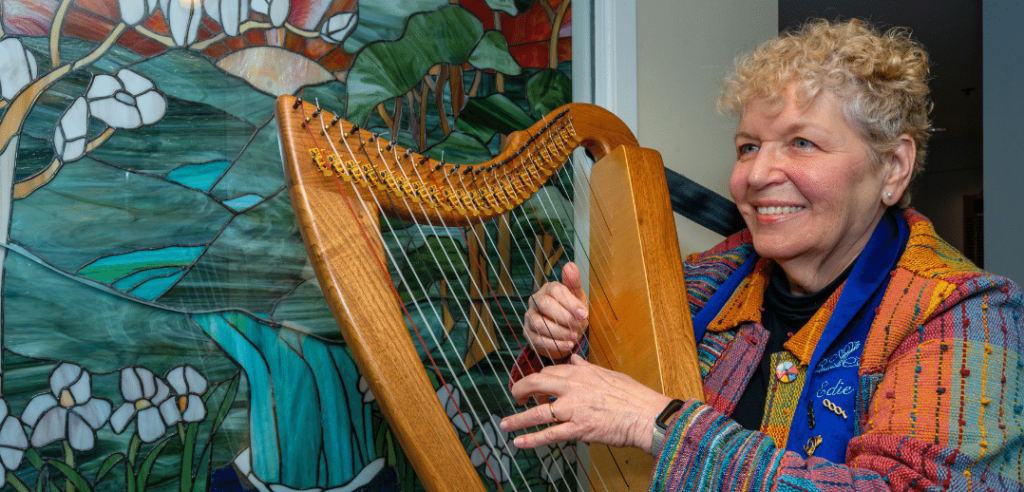When you look at everything that Edie Elkan has done in the last two decades, you might begin to wonder if she is making up for lost time. Her therapeutic music program, Bedside Harp, has grown from an idea in her head in 2001 to a wide-ranging organization that has delivered harp therapy sessions to more than 100,000 patients, taught more than 830 people of all ages to play the harp for their own healing and enjoyment, and graduated 97 certified harp therapists. Elkan took a round-about path to therapeutic harp work, discovering it later in life. Despite the feverish pace with which she has worked for the last 20 years, Elkan says she doesn’t wish she would have started earlier. “I wasn’t qualified when I was younger,” she says. “I think you have to go through some stuff in life not only to do this work, but certainly to teach it.” Elkan has definitely been through her fair share of trials. We caught up with her to talk about those difficulties and how they have helped bring her to this point.
Harp Column: For our readers who don’t know about Bedside Harp, can you explain what it is and what you do?
Edie Elkan: Bedside Harp is both an educational organization and a service organization. We see harp therapy on a continuum, from playing the harp for your own enjoyment and healing, and then by extension, playing for others. As an educational organization, we teach people who want to learn to play just for themselves, and we train and certify those who want to play in healthcare. As a service organization, we contract with area hospitals and hospices, but mostly hospitals in Pennsylvania and New Jersey. We’ve had contracts with 13 hospitals and at our flagship hospital, Robert Wood Johnson Hospital in Hamilton, New Jersey, for 21 years. That is where we launched our program.

HC: Tell us about the first time that you played your harp in a hospital setting.
EE: The first time I played in the hospital setting, I actually played for my husband, who was in critical care. He had a medical misadventure, and there were some really hairy days there. I had already been trained to play in healthcare. I had played in hospice settings, but I hadn’t played in hospital settings. For some reason, I thought to bring my harp into the ICU to play for my husband, and when the nurses saw me bringing in my small therapy harp, they said, “You can’t do this here.” And I said, “Well, I can because I’m going to play for my husband.” I didn’t know then if he was going to survive. He was on all kinds of life support with ventilator tubes coming in and out of his body. So they closed his door, and I sat and played. Of course they have monitors of each patient at the nurses’ stations. So after five or 10 minutes of playing, they came rushing into the room and said, “What are you doing? All of his numbers are normal!” I just looked up, and I said, “I’m playing love songs.” So they opened the doors and said, “Play for everybody!”
HC: That’s a powerful story. Tell us how your collaboration with Robert Wood Johnson Hospital came about.
EE: I was offering harp therapy for two years as a volunteer before a major medical organization agreed to partner with me to run a harp therapy school from their facility. As a volunteer, I had been playing in medical facilities like nursing homes, hospices, and long-term care facilities, but not hospitals. But nobody wanted to pay for it. I had probably played over 1,000 hours as a volunteer, which is always wonderful—we always give some of it away. But if I wanted to train people and to launch this as a legitimate field, I felt that I really needed a medical facility to buy into the idea. I would have to charge for training, which is pretty rigorous with all the classroom hours and an intensive internship. Once people graduated from the program and were certified, I felt very strongly that I wanted them to go out and be able to earn money. If I couldn’t get a medical facility to buy into it, then they would have no chance at all. This was all in the wake of 9/11. In September, right after that, I was asked to play again as a volunteer at a hospital that was hosting a healthcare conference. They asked if I would play during their lunch hour, and I said I would as long as I could talk a little bit about this dream of mine–—Bedside Harp. I named it Bedside Harp because I really wanted people to immediately understand what it is that we do. At that event two administrators from Robert Wood Johnson University Hospital in Hamilton, N.J., immediately embraced the concept. They invited me to their hospital and asked me how much I wanted to charge them for this. I actually had to get back to them because I didn’t know what to charge, in that moment—nobody had ever offered to pay me before. [Laughs] They were very gracious. They shadowed me, and they had me walk through their patient areas and into patient rooms. They said, “Whatever you want to do, we want you to do it here.” That was in October of 2001, and I didn’t start Bedside Harp until February 2002 because I wanted to figure out what this was going to look like in a hospital setting and how it was actually going to work. [Robert Wood Johnson Hospital] has supported us, cheered us on, and been a true partner for these 21 years.

HC: That’s fantastic. I have to imagine that having the support of a hospital like that on your side probably did a lot for you in carrying out your vision for the program. How much of Bedside Harp as an organization did you really have formulated in your head when you began, or did that sort of evolve with time?
EE: For two years I’d been thinking about it. I had planned it. It was all in my head. And so, at that October meeting with Robert Wood Johnson—Hamilton, I was prepared. And they couldn’t have been more excited about it, especially about being the first hospital to take this on. Within that year, I had another hospital jump on, and three or four years later, I was in five hospitals.
HC: Was Bedside Harp the first harp therapy program in a hospital setting?
EE: Other places had harp therapy, but we were the first program to be exclusively hospital-hosted. I don’t think any of the other programs contract directly with the facilities in which their students play their internships.
HC: Obviously, there are several harp therapy programs—what do you think differentiates Bedside Harp?
EE: Well, the first thing is that we are also a service organization. So we work primarily in acute care and behavioral health hospitals. During the pandemic in March of 2020, we had been working with six hospitals and everything shut down overnight except for our behavioral health hospital. We worked throughout the pandemic in that hospital because they view harp therapy as an essential service. But we felt [the effects of] the pandemic severely—you have six contracts and suddenly you only have one.
HC: So how did you navigate that?
EE: After I stopped shaking? [Laughs] It was really scary. We were 18 years in at that time, and I had always envisioned that we would just keep on going and going and going. And what about all the people who were in our program needing to do their internships? There was a lot to navigate. Our hospitals stayed in touch with us throughout. We began playing outside in the main entrance of Robert Wood Johnson Hamilton for four months, and that helped. I took advantage of some of the stimulus opportunities that were offered—Bucks County [where I am located] offered grants for small businesses, and that helped sustain us. And then what happened was something totally unexpected. I had always done in-person classes and in-person teaching, but now in-person was impossible. So I went on the internet, and now [Bedside Harp] has students from all over the world who are training with us through Zoom, which is extraordinary. So where we lost a number of hospital contracts, we wound up gaining a lot of students—more students than we’ve had in years.
HC: It’s interesting how many unintended consequences came out of that time. You were a musician long before you started Bedside Harp. Tell us about your musical background and how you came to the harp.
EE: I came to the harp my first day in high school. We had just moved over the summer, and I was starting in high school. I was upset because I had to go to a high school where I knew no one. With strangers all around me that first day, I somehow got lost going from one class to another and wound up in the music department where I looked into a practice room and saw a harp for the first time. I fell in love at first sight. I totally forgot about the class that I was supposed to go to, and I tracked down the orchestra teacher and declared to him, “I want to play this instrument.” I grew up in Philadelphia, and this was a Philadelphia school. Carlos Salzedo was holding court at Curtis, and it was fabulous because we would go for Friday afternoon concerts at Curtis, and we’d see him. I had hoped to study with him, but he passed away the year before I was ready to go up to Maine to his summer harp colony. So it was all very rich. I studied with my first harp teacher, Mary Ann Castaldo. From there, I went to the Philadelphia Musical Academy, which is now part of the University of the Arts, and there I studied with Marilyn Costello. When she was on tour with the [Philadelphia] Orchestra, I studied with Edna Phillips—all of these harp legends!
HC: You were in the right place at the right time.
EE: Absolutely.
HC: What high school did you go to?
EE: It was Northeast High School. It was the only high school in Philadelphia other than Girls High that had a harp. So if I had gone to the school that I wanted to go to because all my friends were there, then none of this would have happened.
HC: So if you started on a pedal harp, when did you discover the folk harp?
EE: Well, I went to the Philadelphia Musical Academy and studied under these really great teachers…until I ran out of money. We all know the harp is an expensive endeavor, and I never had enough back then to buy my own concert harp; I always rented. I worked to be able to support the rental, and also my schooling. I had a music scholarship, but it was only partial, and I was taking two private harp lessons a week, which was over and above the tuition for the school. So I eventually ran out of money. I was devastated because throughout high school and the two and a half years and Philadelphia Musical Academy, I ate, slept, and drank harp. You were expected to practice six hours a day on your main instrument, and I did. I minored in piano and had to make time to practice that as well. And then I was working on top of everything. Back then there were no opportunities to go to school part-time. You either had to go full-time or you didn’t go. So I wound up having to drop out. I was devastated because I had foregone so many things to do this, and the harp was everything to me. So, suddenly, I didn’t have a harp.
Then 28 years after I last plucked a string, three people in my life died within eight months of each other. The last one to pass away was my friend Marie Mackle. We were the exact same age—in our 40s. When somebody your age dies, it really drives home the whole idea of your mortality. So I went to a grief counselor, because I was really having problems processing all that had happened. My whole world had changed within eight months. My counselor’s last question to me on my way out was, “What can you do to bring joy back to your life?” I thought, “Joy? I’m so far away from joy. What is she talking about?” I couldn’t even relate. I went to my car, put the key in the ignition, and boom. I knew I had to return to the harp. That’s what I needed to do. That’s my answer. I have to go back to the harp even though I hadn’t touched one in 28 years. I would go to orchestra concerts and purposely didn’t look over in the direction of the harp. It was just too painful, frankly, and I didn’t even get in touch with that pain until three people in my life died. Suddenly I realized, “Oh, grief is grief.”
HC: Right, you had grief about losing the harp in your life.
EE: Yes, I did. Marie Mackle, my friend, had left me some money, and so I went home and announced to my husband, “I am buying a harp.” I found my first harp teacher, Mary Ann Castaldo. She wasn’t even playing anymore; she had retired. We got on a plane and we flew out to Lyon & Healy, and I bought myself a Salzedo concert grand.
HC: No kidding—after not touching a harp for almost three decades?
EE: Right. So [Mary Ann Castaldo] got me started again, and I ordered all of the music I remembered playing, but I needed instruction. I was at the World Harp Congress out in Tacoma, Washington, and someone recommended I study with Elizabeth Hainen who plays with the Philadelphia Orchestra. So I wrote her a letter explaining who I was and telling her my story. She called me and we started chatting like we had known each other for years. At the end of the conversation, I said, “By the way, will you teach me?” And she said, “Of course!” So I studied with her for six years.
HC: So you’ve now studied with most of the major Philadelphia harpists of the last 50 years. That’s quite a story. So then when did the lever harp or folk harp enter your life?
EE: I didn’t know anything about the lever harp until I saw one at the World Harp Conference in Tacoma. I was just amazed at looking at all these pedal-less harps playing together and doing all kinds of interesting things. I turned to the person who was sitting next to me and said to her, “I’ve never seen these harps before. What kind of harps are they?” She told me they were types of folk harp, and we got into a conversation. It turned out to be Louise Trotter who I was sitting next to. [Laughs] I had no idea who she was at the time.
HC: Right, your paths would not have crossed before.
EE: No, not at all. So that was the first time I saw folk harps, and I will admit I wasn’t impressed because I had this big Salzedo concert grand and I was a concert harpist, and that’s just a folk harp. And then one night I was practicing, and my husband came into the room and told me to come watch this segment on Dateline NBC about Ron Price who was an early pioneer of using the harp as an instrument of healing. I immediately knew—that’s what I’m doing. I’m healing myself, and I now I can use this to heal others. So that was my first understanding that this is powerful stuff. I had already experienced the power of it. I thought it was because I was trying to resurrect my old passion for the harp, and it was that, but it was also that I was feeling the vibrations. I was hugging the instrument, plucking the strings with my bare fingers. It was an intimate experience, and that’s what I needed in that time of grief.
HC: You’ve been involved in some research about what harp therapy can do to reduce stress. Can you tell us a little bit about that research?
EE: Research has always been part of my four-part mission in healthcare for this program. The first part is to teach people to use the harp for their own healing and enjoyment. The second is to be able to play for others. The third is to train and certify people to play in healthcare because it is so needed. And the fourth is to collaborate with medical facilities in research projects. Bedside Harp has been involved in about four formal research projects through the years. The first research project we did was awarded the prestigious first place prize by the Society for the Arts in Healthcare [now called the Arts and Health Alliance], which was then based out of Washington, D.C. The project involved playing the harp for 20 minutes for patients who were actively receiving chemotherapy. They would assess themselves—how they felt physically, spiritually, emotionally before the session, and then again after the session. I was the only harpist who played in that project because we didn’t want to have different harpists coming because that might be a factor in the outcomes.
HC: Right, so you had to control for that.
EE: There was no question about [the patients’] anxiety level and their stress levels [in that study]. We’ve done other studies with hospitals, but that was probably the most successful one because we had the most controls in place, and the people at the hospital took it seriously and followed all the protocols.
HC: What about the harp makes it such an effective instrument for this work?
EE: The vibrations of these freely ringing strings really do make a difference. You notice it not only with patients who are viable, but also with the sickest patients, the ones who are on life support. You can see how their breathing normalizes, how their brow is no longer furrowed. You can read the body language and see the effects of this. I was playing for long-term ICU patients in Paramus, New Jersey, and the last patient that I was asked to play for was a young woman—beautiful and slender. Her mother was in the room and something got me to play “Can You Feel the Love Tonight.” Sometimes I’ll play familiar tunes, sometimes I’ll just noodle and play unfamiliar tunes. But I frequently go with my intuition. [The patient] was not quite in a fetal position, but she was kind of hunched in the bed, and she was in a coma. As I was playing, one foot came out, and her toes were like a ballerina’s toes, and she was moving them to the rhythm of the song I was playing. I had never had that happen before. Afterwards, I asked the person who was taking me around, “Did you see what happened?” And she said, “Oh, yes, I saw what happened. She was a ballerina, and she had an accident. She’s been in this coma ever since.” Apparently the music just came through. I don’t know if she ever awakened, but there are things about what we do that we can’t really explain.
HC: Is there anything beyond the size of the lever harp that makes it more effective than a pedal harp? I’ve seen that you play with a lever harp harnessed to your body.
EE: Yes, that way, you’re out of everybody’s way. There are gurneys coming through and wheelchairs and people rushing from one place to another. I’ve been to conferences where hospital people would come up to me and say, “Oh, I’m so glad that I stayed for your presentation, because when I heard harp, I envisioned a concert harp sitting in the hallway with a music stand and harpist sitting on a chair, and that’s just not appropriate for hospital hallways, frankly. You have to be able to get out of town quickly, and you don’t want anybody tripping over any of your equipment or your instrument or your chair. So I play a 23-string instrument, and it weighs six pounds because I want the lightest weight possible. And that’s my go-to harp.
HC: Tell us what a typical day would be like for you in the hospital.
EE: It takes a while to build up your endurance, to be able to stroll and play. And remember, we’re not just playing—our focus is on the patient or on the receiver, and we really need to study what’s going on. When I walk into a room, I’m taking in a lot of information about what’s happening in the room. We do not go into patient records, so we don’t know people’s diagnoses or prognoses. I think [the patients] get that, because we’re usually the only ones who enter their room who are not going to ask for blood from them or give them a shot or take their temperature. We’re just standing there playing, and if they don’t want [the music], we want them to let us know that too, because that actually empowers them. That’s about the only thing in their hospital experience they can say no to.
HC: How often will that happen where someone will say, no thanks, I don’t want this?
EE: It happens, and it’s part of the training of my students not to take it personally. It has nothing to do with you or how you’re playing or what you’re playing. It has to do with where they are in that moment. If they’ve just received a terminal diagnosis and they see a harp, maybe that’s something they just don’t want to deal with.
In a typical day we only count our playing hours, not any of the time we spend getting ready to play. We document everything and we send the hospitals this documentation. The point of the documentation is to put the reader in the room with you so that they get to see what you’re seeing. So you have to really be very observant and pay attention to what’s going on to be able to write up your notes afterward. And that’s really serious because in healthcare, if you don’t document it, it didn’t happen. [Our documentation] is the main reason I believe that we’re in our hospitals for our lengthy contracts. I never wanted what we offer to be a flavor of the month. I wanted it to be an integral part of the environment and healthcare offerings. And the only way you can do that is if you let the higher-ups see what you’re doing. And the only way to do that is to have good documentation. So I may play only two hours in a facility, but I’m going to be spending time writing up my notes and processing going into and out of the hospital. So there is a lot of time involved beyond just the hours spent playing.
HC: One thing we haven’t talked about, but is important to clarify for our readers—can you explain the difference between what you do—harp therapy—and music therapy?
EE: Oh, that’s probably the most important thing we’re talking about here. Music therapy is a five-year, intensive, academic study program. It involves psychology training, music training, and so many other things. The easiest way I can describe the difference between the two is that the patient responds to the therapist in music therapy. The patient responds to the music in harp therapy. So we are a conduit for the music. And we’re not therapists in the sense that music therapists are therapists. We don’t have psychology training, we have life experience and our intuition. Harp therapy is more intuitive. You really need to understand that each patient is different. You can’t have ten tunes and say these are the tunes I’m going to play no matter what because I’ve memorized them. The situation may call for something completely different and you have to change things on a dime. Also, music therapists actually have access to records, patient records; we do not. We work alongside music therapists in some of the facilities that we play. But we’re not music therapists, we are therapeutic musicians.
HC: Most people are enjoying retirement at your age, and here you are, still working at this full steam. What keeps you going with this work?
EE: Frankly, it took me a while to get started. Some years ago I was being interviewed by this person who was probably in her twenties, and she asked me, “Don’t you wish that you were younger when you started this?” I looked at her, and I said, “I wasn’t qualified when I was younger.” I think you have to go through some stuff in life not only to do this work, but certainly to teach it. We do train some younger people every so often. I’m not thrilled about teaching young people how to do this work because they haven’t lived enough. They haven’t been beaten up enough. They haven’t had the experiences. We play at the bedside of people in all states of disarray—the depressed, the seriously ill, the dying. I think you have to earn the right to do this work.
HC: What are some of the biggest challenges for people who go through your Bedside Harp program?
EE: I’ve had concert harpists come to the program, and sometimes it’s more challenging for them than it is for somebody who’s new at the harp, because they’re used to playing many notes as fast as they can and as loud as they can, and, of course, perfectly. But that’s not harp therapy. We have to be willing to change things on a dime. I teach people to play by ear and improvise. I was never taught those things when I was learning how to play. I was taught to play what’s on the page. But you couldn’t possibly learn the number of tunes that you’re called upon to play in this work. Sometimes it’s a challenge for concert harpists to realize that the goals of playing in a therapeutic setting are very different from those they’ve been trained so well for.
HC: What characteristics make someone a good candidate to go through this training and do this work?
EE: I can teach anybody to play the harp for therapeutic work. I can’t teach them to have compassion, to have a heart of caring, and to have this sense of serving another with their instrument. To me, those qualities are far more important initially than [musical ability]. When people come to the program, I want to know why they are doing it. This is not for everybody. Not everybody wants to stand by the bedside of people in all sorts of disarray. So what makes you want to do this work? Consequently, the people who come to Bedside Harp are the most extraordinary group of people. That is one thing I didn’t anticipate when I came up with this whole idea—the community part, the lifelong friendships that have been made—that’s Bedside Harp. I just sit back and smile and love it. •






